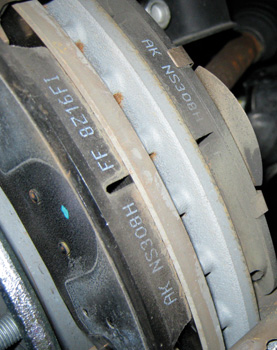 The break in or bedding procedure for pads can very greatly from manufacturer to manufacturer. It could be 30 30MPH stops with 30 seconds between stops or it could be no break in procedure at all.
The break in or bedding procedure for pads can very greatly from manufacturer to manufacturer. It could be 30 30MPH stops with 30 seconds between stops or it could be no break in procedure at all.
All brake pads go through bedded-in with the rotor they will be used against to maximize brake performance. The process involves a gradual build up of heat in the rotors and pad compound. But, how this gradual heat and bedding process takes place is determined by the manufacturer of the pad.
Taking a vehicle for a test drive after a brake job lays down a thin layer of transfer film on to the rotor surface. Following the bed-in procedures provided by the manufacturer will assure a smooth, even layer of transfer film on the rotor and will minimize brake judders.
The break-in procedure should not be there to “cure” a pad and harden the resins. If a brake pad set produces an excessive amount of smell or smoke on the initial bedding procedure, chances are that there is something wrong with the pad and how it was manufactured.
There are not any set rules or universal procedure to bedding or breaking-in brake pads. Due to the fact that every manufacturer has different manufacturing processes, each has their own recommended procedure. Rotors should be clean and free of friction material. Old material can contaminate the new pads and cause a noise or performance problem.
Here is a small sample of recommended procedures, check the box first for for what brake of brakes you are installing:
AKEBONO
400 to 500 miles of moderate driving is recommended. Consumer should avoid heavy braking during this period.
ATE
400 to 500 miles of moderate driving is recommended. Consumer should avoid heavy braking during this period.Bendix Brakes
A series of controlled moderate speed stops (15-20 Stops from 30-mph w/30 sec cool down) is required to properly “burnish” or break-in a new set of pads. During this initial stopping period, the process of lining transfer from the disc pads to the rotor surface helps condition the rotor surface to properly seat the brake pads. All pads are cured and all pads need to be burnished.HAWK
After installing new pads make 6 to 10 stops from approximately 35 mph with moderate pressure. Make an additional two to three hard stops from approximately 40 to 45 mph. Do not allow the vehicle to come to a complete stop.When completed with this process, park the vehicle and allow the brakes to cool completely before driving on them again. Do not engage the parking brake until after this cooling process is compete.
Monroe Brakes
Proper break in is one of the most important factors in determining brake pad performance. Proper break in during the final test drive seats the pads for optimum performance. Monroe® recommends 15 to 20 gentle stops from 20 mph. Monroe® Premium Brake Pads’ positive molding technology does not require burnishing. Advise the customer to avoid hard stops for the first week.
400 to 500 miles of moderate driving is recommended. Consumer should avoid heavy braking during this period.
ATE
400 to 500 miles of moderate driving is recommended. Consumer should avoid heavy braking during this period.Bendix Brakes
A series of controlled moderate speed stops (15-20 Stops from 30-mph w/30 sec cool down) is required to properly “burnish” or break-in a new set of pads. During this initial stopping period, the process of lining transfer from the disc pads to the rotor surface helps condition the rotor surface to properly seat the brake pads. All pads are cured and all pads need to be burnished.HAWK
After installing new pads make 6 to 10 stops from approximately 35 mph with moderate pressure. Make an additional two to three hard stops from approximately 40 to 45 mph. Do not allow the vehicle to come to a complete stop.When completed with this process, park the vehicle and allow the brakes to cool completely before driving on them again. Do not engage the parking brake until after this cooling process is compete.
Monroe Brakes
Proper break in is one of the most important factors in determining brake pad performance. Proper break in during the final test drive seats the pads for optimum performance. Monroe® recommends 15 to 20 gentle stops from 20 mph. Monroe® Premium Brake Pads’ positive molding technology does not require burnishing. Advise the customer to avoid hard stops for the first week.